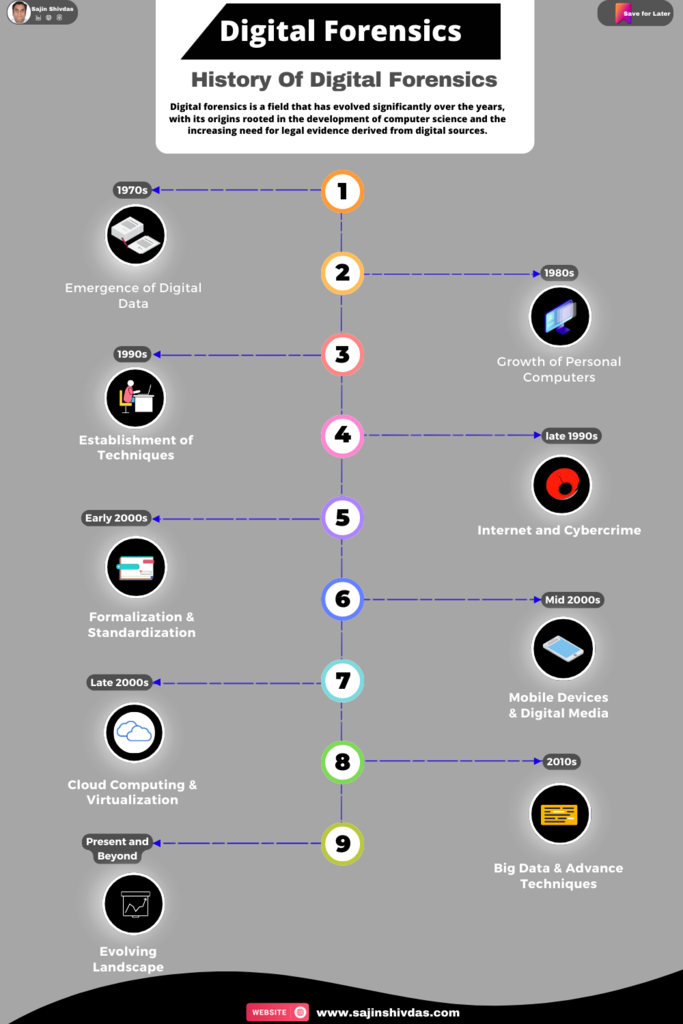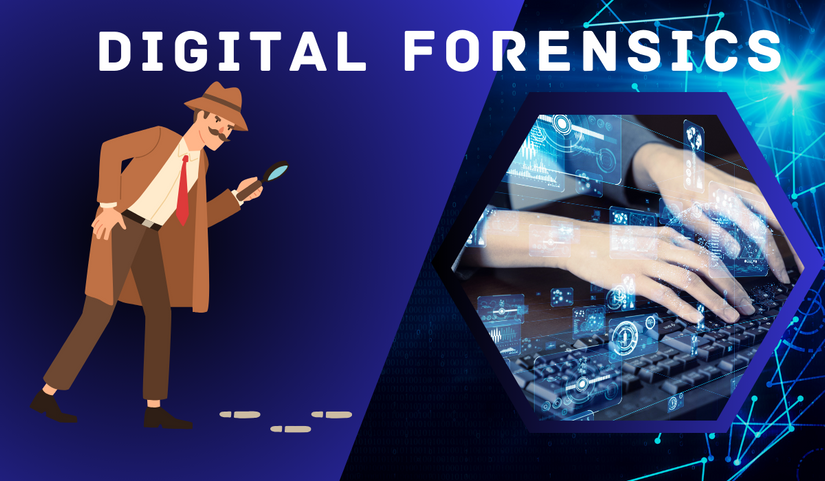History of Digital Forensics
The expansive history and evolving landscape of digital forensics, the content will be divided into sections to cover each significant period. Each section will outline key developments, breakthroughs, and challenges, aiming for a comprehensive understanding suited for an audience interested in cybersecurity, digital forensics, and the evolution of digital technologies.
1970s – Emergence of Digital Data
- Introduction to the concept of digital data.
- Early challenges in managing and securing digital information.
1980s – Growth of Personal Computers
- The proliferation of personal computers and its impact on data storage and security.
- The beginning of digital crime and the need for investigative techniques.
1990s – Establishment of Techniques
- Development of foundational forensic methodologies.
- Key cases and software that defined this era.
Late 1990s – Internet and Cybercrime
- The rise of the internet and the exponential increase in cybercrime.
- The evolution of digital forensics in response to new types of digital threats.
Early 2000s – Formalization & Standardization
- Efforts towards formalizing procedures and standards in digital forensic investigations.
- Introduction of international guidelines and organizations.
Mid 2000s – Mobile Devices & Digital Media
- The challenge of mobile devices and the proliferation of digital media.
- New tools and techniques for forensic analysis.
Late 2000s – Cloud Computing & Virtualization
- The impact of cloud computing and virtualization on digital forensics.
- Adjusting methodologies for these new environments.
2010s – Big Data & Advanced Techniques
- The challenge of big data in forensic investigations.
- Advances in forensic technologies and methodologies.
Present and Beyond – Evolving Landscape
- Current trends and future directions in digital forensics.
- Emerging technologies and their potential impact.

History of Digital Forensics
1970s
Emergence of Digital Data
The 1970s marked the dawn of the digital age, characterized by the transition from analog to digital technologies. Computers, which were once massive, room-sized machines used primarily by governments and large corporations, began to evolve into more compact systems capable of storing data digitally. This period saw the birth of digital data as we know it today—binary information that could be easily stored, processed, and analyzed by computers.
Despite the technological advancements, this era faced significant challenges in managing and securing digital information. With the concept of digital data still in its infancy, early computer systems were prone to data breaches and security vulnerabilities. There were no established protocols or methodologies for investigating digital crimes, primarily because such crimes were rare and largely unforeseen.
1980s
Growth of Personal Computers
The 1980s witnessed a monumental shift in the landscape of digital technology with the advent of personal computers (PCs). This decade was marked by the transition from large, inaccessible computers to smaller, affordable, and widely available machines. Companies like Apple, IBM, and Microsoft were at the forefront, revolutionizing how individuals interacted with digital technology, both at work and in the home.
The proliferation of PCs brought about a significant increase in the volume of digital data being generated. For the first time, individuals could store vast amounts of data on their personal devices. This newfound capability, however, also introduced new vulnerabilities. As more data became digitized and stored on PCs, the opportunities for digital crimes such as hacking, phishing, and software piracy expanded dramatically.
This era underscored the need for investigative techniques specific to digital environments. Early forms of digital forensics began to emerge, primarily focusing on retrieving and analyzing data from personal computers. Law enforcement agencies and private sector companies started to recognize the importance of digital evidence, which led to the development of basic tools and methods for examining digital data.
1990s
Establishment of Techniques
The 1990s are often regarded as the foundational years for digital forensics as a formal discipline. During this period, the internet began to gain widespread adoption, and with it, the complexity and frequency of digital crimes increased. This necessitated a more structured approach to digital investigations, leading to the establishment of various techniques and methodologies that form the basis of modern digital forensics.
Key to this era was the development of forensic software tools designed to recover, analyze, and preserve digital evidence in a legally acceptable manner. Forensic specialists began to formalize the process of digital investigation, establishing protocols for the collection, examination, and documentation of digital evidence.
Significant cases during the 1990s highlighted the importance of digital forensics. One landmark case was the investigation of Kevin Mitnick, a notorious hacker, which showcased the potential of digital forensic techniques in tracking and capturing cybercriminals. The resolution of such cases demonstrated the effectiveness of digital forensics and cemented its importance in both law enforcement and the private sector.
Late 1990s
Internet and Cybercrime
The late 1990s marked a critical turning point in digital forensics, largely due to the rapid expansion of the internet. As the World Wide Web became more accessible to the public, it revolutionized how people communicated, conducted business, and managed data. This era ushered in unprecedented connectivity, but with it came a significant surge in cybercrime. The internet’s vast, borderless nature made it an ideal ground for cybercriminals to operate with anonymity.
Cybercrimes such as identity theft, online fraud, and the distribution of malware became increasingly common, posing new challenges for law enforcement and cybersecurity professionals. The nature of these crimes necessitated the development of specialized investigative techniques to trace digital footprints across the web. Digital forensics expanded its focus from local computer systems to the complex, interconnected environment of the internet.
This period also saw the establishment of dedicated cybercrime units within law enforcement agencies worldwide. The FBI’s Cyber Division, for example, was formed to address internet-related crimes specifically. Digital forensic investigators began utilizing internet artifacts, such as browser histories, email logs, and IP addresses, as crucial pieces of evidence in their investigations.
Early 2000s
Formalization & Standardization
Entering the early 2000s, the digital forensics community recognized the need for a more structured and standardized approach to investigations. The field began to formalize, with the introduction of international standards and best practices for digital forensic procedures. This era was characterized by a concerted effort to standardize the process of collecting, analyzing, preserving, and presenting digital evidence in court.
Organizations such as the Scientific Working Group on Digital Evidence (SWGDE) and the International Organization on Computer Evidence (IOCE) were instrumental in developing guidelines that shaped the practices of digital forensic professionals. These standards ensured that digital evidence was handled in a manner that maintained its integrity and admissibility in legal proceedings.
The early 2000s also saw the emergence of formal education and training programs in digital forensics. Universities began offering courses and degrees in the field, contributing to a growing body of academic knowledge and research. This period marked the transition of digital forensics from a niche skillset to a recognized professional discipline.
Mid 2000s
Mobile Devices & Digital Media
The mid-2000s witnessed a seismic shift in digital forensics, prompted by the widespread adoption of mobile devices like smartphones and tablets. These devices became ubiquitous, storing vast amounts of personal and sensitive data. Digital media, too, exploded in variety and volume, with digital photographs, videos, and audio recordings becoming central to personal and professional life. This period marked a significant expansion in the scope of digital forensics, as investigators now needed to address the unique challenges posed by these new forms of technology.
Mobile devices introduced complex issues for forensic analysts due to their diverse operating systems, proprietary formats, and the frequent updating of hardware and software. The field had to develop new tools and techniques for extracting data from these devices, often encountering encryption and other security measures designed to protect user privacy. Digital forensic tools evolved rapidly during this time, with a focus on mobile data acquisition, analysis, and reporting.
Digital media posed its own set of challenges, particularly with the authenticity and manipulation of digital images and videos. Forensic experts began employing sophisticated methods to verify the integrity of digital media, using metadata analysis and advanced imaging techniques to detect alterations or forgeries.
Late 2000s
Cloud Computing & Virtualization
As the decade progressed, cloud computing and virtualization began to transform the IT landscape. These technologies allowed for the storage of data offsite in remote servers (the cloud) and the creation of simulated environments (virtualization), respectively. This shift presented new frontiers for digital forensics, as data was no longer confined to physical devices directly controlled by users or organizations.
The decentralization of data storage posed significant challenges for forensic investigations. Traditional forensic methods, which relied on physical access to the data storage devices, were not directly applicable in cloud environments. Digital forensics had to adapt by developing remote collection techniques, ensuring legal and ethical compliance when accessing cloud-stored data.
Virtualization technology, which allows for the creation of multiple simulated computing environments on a single physical hardware platform, also introduced complexities in forensic investigations. Analysts needed to understand and navigate these virtual environments to locate and extract relevant evidence. The industry responded with specialized tools and methodologies for forensic analysis in virtualized and cloud environments.
2010s
Big Data & Advanced Techniques
The 2010s are characterized by the emergence of big data and the development of advanced forensic techniques to manage the sheer volume, variety, and velocity of data. The explosion of data generated by individuals and organizations necessitated more sophisticated analytical tools and methods. Forensic investigators began leveraging big data analytics to sift through large datasets more efficiently, identifying relevant pieces of evidence amidst vast quantities of information.
This era also saw advancements in artificial intelligence (AI) and machine learning (ML), which were increasingly applied in digital forensic investigations. AI and ML algorithms were developed to automate the process of data analysis, including pattern recognition, anomaly detection, and predictive analytics. These technologies significantly enhanced the efficiency and accuracy of digital forensic investigations, enabling experts to uncover insights that would be difficult, if not impossible, to find manually.
Present and Beyond
Evolving Landscape
As we move into the present and look towards the future, the landscape of digital forensics continues to evolve rapidly. The proliferation of Internet of Things (IoT) devices, advancements in encryption technology, and the increasing sophistication of cyber threats pose new challenges and opportunities for digital forensics.
Emerging technologies such as blockchain and quantum computing are set to further transform the field, offering both novel tools for forensic investigators and new vectors for cybercrime. Forensic professionals must stay ahead of these developments, adapting their techniques and tools to the changing technology landscape.
The future of digital forensics will likely see a greater emphasis on cross-disciplinary collaboration, integrating insights from cybersecurity, data science, and legal studies. As digital technology becomes increasingly integrated into all aspects of society, the role of digital forensics in maintaining security and justice becomes ever more critical. The field must continue to evolve, developing new methodologies to tackle the cyber challenges of the future while upholding ethical standards and respecting privacy rights.









